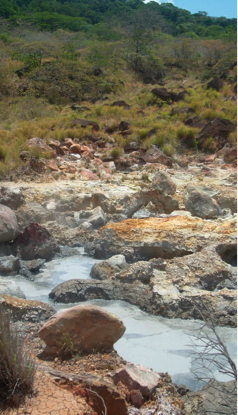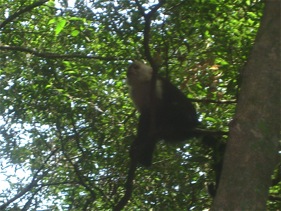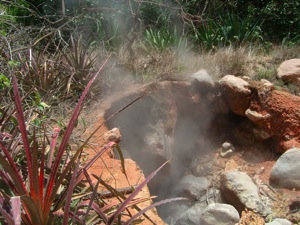
Rincón de la Vieja
Costa Rica has five active volcanos: Poás, Turriabla, Irazú (see blog entry Irazú), Arenal (see blog entry Arenal), and Rincón de la Vieja. Today I visited Rincón de la Vieja for the first time. To get to the National Park, located about 25 km from Liberia, Guanacaste, one has to enter Hacienda Guachipelín, and since it is private property, they charge 700 colones per person for the right to use their road. Doesn’t seem fair and perhaps there is another entrance to the park via public roads, but we wanted the entrance to the Pailas Sector and this was the only way. At the entrance to the park, we paid the standard fee ($10 if you’re a tourist, $1.75 if you’re a resident). Luckily, the guard had the laid-back attitude common to the beach towns, and charged me as a resident even though I didn’t have a cédula to prove it, just the right accent. The two-hour hike in Las Pailas consisted of a large loop, starting at a small river, traversing a cloud forest where we had the privilege of spotting a group of white-faced monkeys, passing by a waterfall, crossing an area filled with steamy fumaroles, bordering a field of aloe vera, going through thermal volcanic mud pools surrounded by multi-colored rocks, and across a grassy field with large volcanic rocks from an ancient eruption. This particular hike didn’t take us to any of its craters but the sights of vapor geysers, steamy stones, and bubbling mud were more interesting; we were witnessing active volcanic activity right in front of us. Also, the varied landscape and number of animals we saw in such a short period made this hike definitely worthwhile.
Cultural Side Note: The volcano’s name Rincón de la Vieja means “Old Woman’s Nook,” referencing the place where Curubanda lived. Curubanda, the story goes, was a tribal chief’s daughter who fell in love with Mixoaca, a warrior from an enemy tribe. Her father, enraged by this forbidden love, killed Mixoaca and threw his body into the volcano’s crater. Curubanda, pregnant and overcome with grief, escaped her village and went to live near the crater. When her love child was born, she threw him into the crater so he could be near the father. Curubanda lived the rest of her life near the crater, she learned the medicinal secrets of the volcanic muds, waters, and plants, and became a well-known healer. People from far away went to the “rincón de la vieja” to seek Curubanda’s healing powers.
Saturday, May 9, 2009





